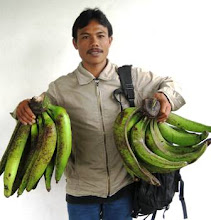Kami temukan kiranya kebanyakan orang Indonesia kurang suka minum kopi. Malah ada yang bangga, "Saya tidak minum kopi, kok." Memang, soal kopi ini sesungguhnya kontroversi. Ada yang suka dan gemar tapi sekaligus tidak (berani) mengabarkan rasa sukanya (apalagi bangga), tapi lebih sering kami jumpai orang yang menyatakan ke-takminumkopi-annya.
Kopi dianggap sebagai mengandung caffein yang merugikan kesehatan dan kalau kecanduan bisa berbahaya bagi tubuh. Begitu, barangkali, pandangan seumumnya tentang kopi.
Namun, kami khawatir juga bahwa barangkali sebenarnya karena kurang tahu tentang manfaat kopi (kecuali membuat orang jadi bisa terjaga), dan khasiatnya bagi tubuh. Tapi, memang mereka yang mengabarkan tentang manfaatnya bisa jadi karena biasnya, misalnya karena dia pro-bisnis kopi, seperti barangkali yang kami lakukan.
Di antara para anggota Serikat Petani Pasundan, terutama mereka yang ada di kabupaten Ciamis, ternyata ada beberapa petani penanam kopi. Tapi, yang begitulah, pada umumnya mereka belum membudidayakannya dengan baik sehingga hasilnya minim. Satu kilogram dihargai Rp18.000 di kota kecamatan Banjarsari, Ciamis Selatan. Untuk meningkatkannya dibutuhkan proses yang tak sebentar.
Salah satunya kami akan mulai dengan menghargai kopi, mempelajari kesaksian orang tentang manfaatnya, bagaimana mengelola kegiatan setelah panen, mempelajari cara minumnya, menggorengnya, menghargai cita rasa kopi, apalagi ya .. banyak ternyata ..
Kurang penghargaan, ada yang berkisah, adalah karenanya kita bersemangat "inlander". Kopi bagus, enak, klas satu, hanya diminum oleh para tuan di negeri-negeri maju. Kita sendiri di sini kurang menghargai kopi kecuali menjadikannya jadi uang. Belanda sudah lama pergi, tapi kita masih serasa dan barangkali nyatanya memang begitu sih .. masih dijajah jua ..
Kita justru minum kopi merek Kapal Api yang kata sementara certificator adalah hanya kulit kopi. Kok kami para petani dan pendukung petani hanya minum kulit kopi? Di mana kopi aslinya, biji kopi sesungguhnya? Ternyata 70 persen diekspor.
Friday, April 11, 2008
Kopi Kapal Api
Thursday, February 28, 2008
Day 8 - How do see them?

They are ripe and supprisingly the "meat" remain firm. Some white fungus appear on the skin of one of them and other appear at the end of bananas next to bunch (?).
We may no longer need to wait before seeing them more ripened. We will cut them and see the 'meat' inside. We'll show you how each day the meat "transform" into until the last day we could no longer eat or cook them.
Wednesday, February 27, 2008
Steam, pounded bananas of getuk from Java
Getuk is among popular snack foods in Indonesia, particularly in Java Island. What is getuk? People mostly make them from cassava being pounded, and then turn them into small loaves by steaming and adding some sugar. But now, and this is the chance, you can make it also out of bananas. And tanduk pisang is the best main ingredient. How do you make it?
Ingredients
- 3 hands of tanduk pisang
- 3 table spoon of sago powder
- 100 gram of ground white sugar (!)
- 100 mililiter of coconut milk
- ¼ tea spoon of salt
- ¼ tea spoon of vanilla powder
Additional ingredients
- Half of mature coconut meat, grated longitudinally
- ¼ tea spoon of salt
- One piece of pandanus leaf
- Banana leaves and, of course, palm leaf ribs to tie (now here people mostly use stapler, what a mess)
How to cook?
- Steam the tanduk bananas until well cooked, then take them and while remain warm, crush them and mix them with the ground sugar and the coco milk. Add sago powder, and mix them well.
- Take a piece of banana leaf; wrap the banana doughy mixture while rolling it with banana leaf as each needed. Pinch each with the palm leaf rib. Steam the rolls for 30 minutes. Take them out and let them cool down as they get somehow firmer. Voila, you get the banana getuk!
- Mix the grated coconut with a little bit of salt, mix well, and add the pandanus leaf, then steam it for some time.
- Cut the getuk into small pieces as you like and spread some grated coco on to them before you taste.
Share us your experience. How do they taste?**
Technorati Profile
Tuesday, February 26, 2008
Day 7: Few remaining green

Indeed, today is the seventh day after the bagja bananas were cut down from the tree. Yet even though many have yellowed, two remain still clearly green, they are all hard if you you press each of their hands. Of course those yellow are slightly softer than the green. They just fell them easily.
You still see them the same fresh after one week.
Interesting.






